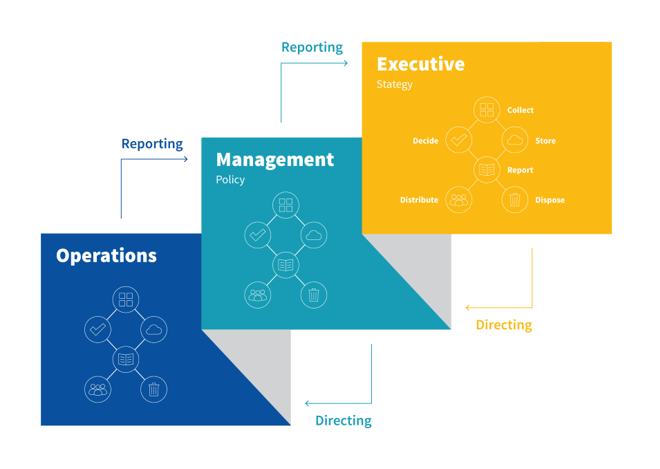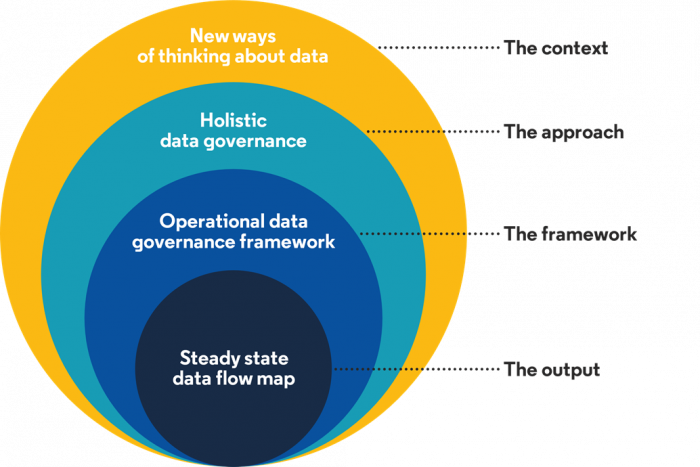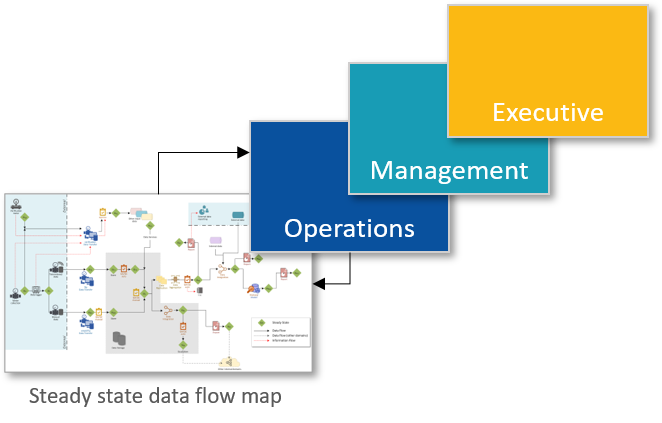This page describes holistic data governance, how it differs from other approaches, why you might consider it, and what it might involve. You can read further detailed guidance linked below or reach out to learn more.
A holistic approach to data governance brings together the top-down focus, common to traditional governance models, and an operational and bottom-up perspective. The resulting joined-up view of data governance extends across the organisation, providing the value of each perspective independently, while enabling them to complement and enhance each other.
When data was simpler, traditional approaches met the needs of most organisations. With hierarchical structures, and well-defined roles and responsibilities, executives, management, and operations staff could focus on their individual concerns in a coordinated manner.
But the role and use of data within an organisation has changed significantly. As a widely valued asset, data no longer stays confined to the defined channels that map well to a traditional governance approach. As a result, traditional approaches struggle, and organisations might suffer from a growing divide between the perspectives and experiences of leadership and operations staff.
For instance, executives might set goals or data policies that don’t work when they meet the reality of operational contexts. Similarly, operations staff might not understand the relevance of direction coming down from above, or worse yet, see it as a burden.
If your organisation experiences these struggles, then a holistic approach to data governance could be useful. However, the implementation of the approach may be best completed over time, based on an organisation’s level of data maturity. By introducing it in steps, you can address concerns as they arise and ease the transition from an exclusively traditional, top-down model.
The holistic approach involves assessing the current state of your data governance across three typical levels of your organisation: the executive, the management, and the operations. This assessment produces a “cascading scorecard” (see Figure 1), a measurement of data governance, which captures the perceived value, risks, and constraints for six areas of data accountability within the three organisational levels.

Figure 1. The cascading scorecard (from ISO-IEC 38505-1-2017 and ISO-IEC TR 38505-2-2018)
Once completed, this assessment can be used to inform a data strategy that aligns with the existing organisational strategy and long-term plans. It also helps you identify and make the most of your data asset’s value, in a realistic fashion (i.e., in the context of relevant risks and constraints).
As part of a holistic approach to governance, you can also adopt the operational Data Governance Framework, and steady states data flow mapping.
The framework scaffolds the holistic approach, describing the roles, capabilities, activities, and decisions required. The steady states data flow mapping realises that framework; the mapping process describes your current state and allows you to begin planning a future state that fills the gaps and meets your needs.
The relationship of these elements, embedded in the wider context, are shown in Figure 2.

Figure 2. The relationship between the context, approach, framework, and outputs.
At the operations level, as well as creating a view of data “on the ground”, data flow mapping can help you capture and share related perspectives upward (Figure 3). This can help you influence management and executive outputs. Likewise, leadership can directly embed policy and strategic consideration into operations with the decision criteria used in steady states data flow mapping.

Figure 3. Steady state data flow map interacting with the cascading scorecard.
The holistic approach is not designed to replace traditional approaches. Rather, it simultaneously reveals the operational or bottom-up view of governance and supports traditional top-down data governance and facilitates the use of oversight mechanisms (boards and committees) to reflect and deliver the authority and responsibilities of the organisation’s governing body. In fact, when data governance is considered holistically, the governing body is better positioned to manage its accountability across all organisational contexts and corresponding perspectives on data.
We have included further detailed resources in a section below. If you would like to explore this approach in further detail, we suggest you read these. We also plan to publish some guidance on steady states data flow mapping in the future.
After detailed reading, you can contact Stats NZ to speak to a subject matter expert about the support available.
If you’d like more information, have a question, or want to provide feedback, please email datalead@stats.govt.nz.
Content last reviewed 10 May 2022.